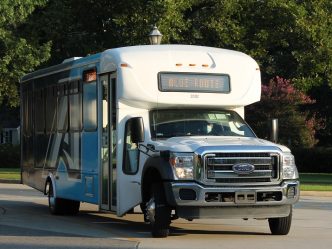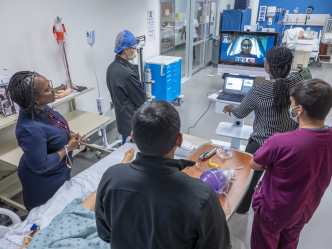Not only is the J. Harold Harrison, M.D. Education Commons earning high praise from the students and faculty who use it, but it’s actually earning the university a good chunk of change, too.
In addition to the ongoing energy savings racked up by using more efficient equipment, the decision to install that equipment has resulted in a Georgia Power rebate of $18,734.85.
“That was just for building it the way we built it,” said Facilities Engineering Manager Mark Williams. “That’s what they’re looking at – less electricity used. Because the less we use, the more they can provide to somebody else.”
The three-story, 175,000-square-foot building opened in October of last year and was designed to be as energy efficient as possible, given the construction parameters.
“The more efficient the concepts or components are, usually the more expensive they are,” Williams said. “So you’re limited by the building’s budget.”
In other words, there’s a balance between energy savings over time versus up-front cost. While more efficient LED lights were used in certain areas of the Ed Commons building, for example, they were considered too expensive to be used throughout.
The decision to go with proximity sensors in most of the rooms, hallways, common areas, and offices may have given the building a “Star Trek” feeling, but it also contributed to the rebate while also allowing students more flexibility when using the building, since the sensors use a variety of methods to power each room separately.
“If there’s motion or sound or heat, they’ll stay on,” Williams said. “But as the building goes down, if there’s no motion or sound or heat, they’ll shut off.”
This is in contrast to the College of Dental Medicine, which uses a lighting control system to schedule power usage. Williams said such systems are expensive to install – a computer system must communicate with every light, which means that every light has to have its own IP address – and difficult to maintain. They also don’t easily allow for irregular or unplanned use, which means the lights often remain on.
“The idea in concept was great, but the upkeep and cost of maintenance was not looked at fully; so when we built the Ed Commons, we screamed, ‘Don’t go to this type, because it limits people,’” Williams said.
The proximity sensors are also tied into the HVAC system, which has seven different air handlers. The lecture rooms also have CO monitors, so each room is automatically cooled to match its needs. A full lecture room will obviously need more air conditioning than a mostly empty one, and the sensors ensure that the empty one doesn’t get more than it needs.
 Augusta University
Augusta University



